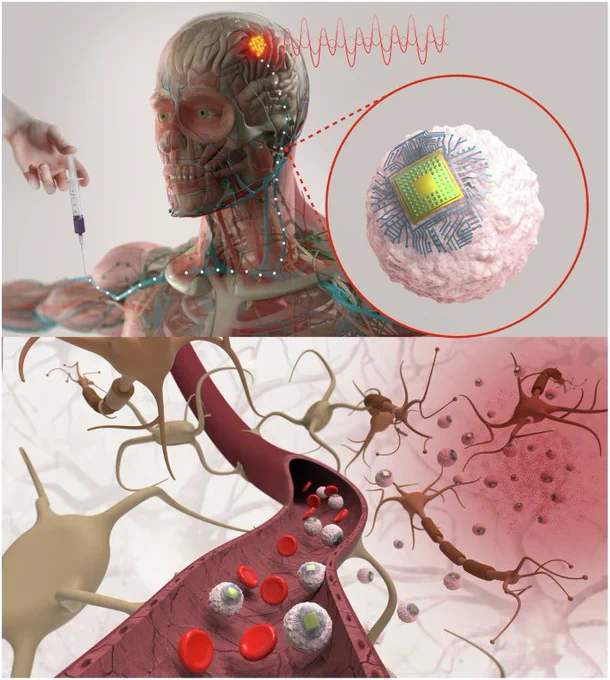MIT have developed bioelectronic devices that, after IV injection, are trafficked through the circulatory system and implant autonomously in brain regions of inflammation.
They also demonstrate that they enable wirelessly controlled focal stimulation of deep brain regions such as ventrolateral thalamic nucleus in the rodent brain providing a nonsurgical brain implant for focal neuromodulation that takes advantage of immune cells’ natural trafficking to sites of inflammation.
They have given electronics that circulate through the vasculature the name ‘Circulatronics’.
Realization of the Circulatronics brain stimulator requires:
(1) The development of efficient wireless free-floating electronic devices that are miniaturized to fit inside the vasculature.
(2) The circulation of these devices without being eliminated from the bloodstream.
(3) Capabilities in the recognition of, and self-implantation in, desired brain regions.
To overcome these challenges, they have built wireless optical energy harvesting electronic devices that are subcellular sized and self-standing with high efficiency.
To achieve point (1) they created hybrids with living immune cells.
(Literal Cyborgs - ieee-ras.org/cyborg-bionic-s…)
To fit and freely move inside the vasculature without clogging, the size of Circulatronics devices must be similar to or smaller than that of the circulating cells (for reference, a circulating cell such as monocyte has a diameter of 12–18 µm).
They developed something called subcellular-sized wireless electronic devices (SWEDs) that are free-floating and that can convert extracorporeally applied fields to electrical energy to enable electrical neuromodulation.
medicalxpress.com/news/2024-…
news.mit.edu/2024/wearable-d…
While there are different modalities for wireless energy harvesting (such as radio frequency, electromagnetic, optical or acoustic) each with its unique characteristics, they focused primarily on the photovoltaic principle, which involves wireless powering via optical fields.
This is because optical modalities provide high spatio-temporal resolution, penetration depth of several centimeters in the human head with intact skull and have already been used for clinical studies.
static-content.springer.com/…
Moreover, photovoltaic devices generate DC potentials, eliminating the need for any rectifying circuits (saving on-chip area and avoiding circuit complexity).
Other modalities can also be employed in future for Circulatronics technology, based on user-defined requirements. Although photovoltaics have been applied previously for neuromodulation (nature.com/articles/s41565-0…), this study by MIT investigates subcellular-sized free-floating photovoltaic devices compatible with circulation through bloodstream for in vivo electrical brain stimulation.
Moreover, none of the previous photovoltaic devices or implants with other modalities (optical, electrical, radio frequency, magnetic or acoustic) have been demonstrated for brain stimulation with high spatial resolution without surgery.
MIT used organic semiconductors (onlinelibrary.wiley.com/doi/…) to leverage the photovoltaic effect, as they have unique advantages such as narrow bandwidth for enabling multiplexing, high optical absorption coefficients, mechanical flexibility allowing better interfacing with soft biological systems and biocompatibility.
They also provide ease of fabrication and compatibility with complementary metal-oxide-semiconductor back-end-of-line processing creating opportunities for integrating advanced functionalities in the future.
sciencedirect.com/science/ar…
nature.com/articles/ncomms21…
MIT finally admitting that they can use nano-scale wireless devices to remotely program areas of the brain.
MIT researchers created microscopic wireless electronic devices that travel through blood and implant in target brain regions, where they provide electrical stimulation.
"The team has been working on circulatronics for more than six years. The electronic devices, each about one-billionth the length of a grain of rice, are composed of organic semiconducting polymer layers sandwiched between metallic layers to create an electronic heterostructure.
They are fabricated using CMOS-compatible processes in the MIT.nano facilities, and then integrated with living cells to create cell-electronics hybrids. To do this, the researchers lift the devices off the silicon wafer on which they are fabricated, so they are free-floating in a solution."
“The electronics worked perfectly when they were attached to the substrate, but when we originally lifted them off, they didn’t work anymore. Solving that challenge took us more than a year,” Sarkar says.
Key to their operation is the high wireless power conversion efficiency of the tiny electronics. This enables the devices to work deep inside the brain and still harness enough energy for neuromodulation.
The researchers use a chemical reaction to bond the electronic devices to cells. In the new study, they fused the electronics with a type of immune cell called monocytes, which target areas of inflammation in the body. They also applied a fluorescent dye, allowing them to trace the devices as they crossed the intact blood-brain barrier and self-implanted in the target brain region.
While they explored brain inflammation in this study, the researchers hope to use different cell types and engineer the cells to target specific regions of the brain.
“Our cell-electronics hybrid fuses the versatility of electronics with the biological transport and biochemical sensing prowess of living cells,” Sarkar says. “The living cells camouflage the electronics so that they aren’t attacked by the body’s immune system and they can travel seamlessly through the bloodstream. This also enables them to squeeze through the intact blood-brain barrier without the need to invasively open it.”
news.mit.edu/2025/new-therap…
Nov 6, 2025 · 9:44 AM UTC







































